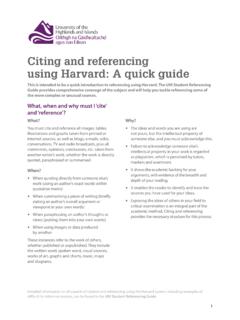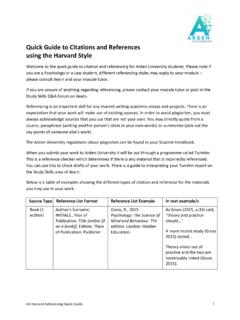Transcription of Student referencing guide - University of the Highlands ...
1 This guide outlines the University of the Highlands and Islands (UHI) Academic Standards and Quality Regulations approved referencing standard for SCQF Level 7 and aboveThis guide is based on the coventry University s harvard reference Style guide produced by the Centre for Academic Writing at coventry University and is reproduced by UHI under a Creative Commons Licence. Version September 2013 Student referencing Introduction 3 Why do I need this referencing guide ? 3 Why must I cite and reference ? 3 When do I need to cite and reference ?
2 4 Does everything have to be cited and referenced? 4 How to use this guide 52. harvard in a nutshell 73. In-text citations 11 Principles and definitions 11 How do I create in-text citations? 11 An example of in-text citations 124. The list of references 14 What information to include in your list of references 14 Where to find publication details 165.
3 Text sources 20 Commonly used text sources 20 Less common text sources 256. Visual sources 35 How do I cite and reference images? 35 How to cite and reference other visual sources 377. Numerical data 41 Using data as part of your text 41 Presenting data visually 418.
4 Audio sources 42 How do I cite lectures? 42 How to cite and reference other audio sources 439. Secondary sources 4610. Frequently asked questions 4711. Further reading 5212. Index 5331. IntroductionWhat referencing is, when it is required and how this guide can help Why do I need this referencing guide ?
5 When producing a piece of written work you need to acknowledge the words and ideas of others that you use. This is done by citing and referencing them. Citing normally refers to a method of indicating in the body of your text that the ideas or viewpoints you are writing about, or the images you are reproducing were originally put forward, or created, by someone else. This could be when you quote, paraphrase, summarise, reproduce an image or chart, and so on. referencing is the method of producing a list of all the sources that have been cited in the piece of work. There are several referencing styles in existence; for UHI undergraduate and taught post-graduate students the approved format used is the standard harvard style.
6 This is a simple system of author-date referencing which is widely used internationally and conforms to the British Standards Institution s BS 5605 for referencing . There are two elements in the UHI harvard reference style: In-text citations in the main body of your writing A separate list of references at the end of your workSome UHI modules have dispensation from the faculty Dean to use a different referencing style, reflecting standard practices in their subject discipline ( history). It is your responsibility to check with your module leaders whether any of your modules have received dispensation for use of a system other than the UHI standard harvard guide will help you to understand why, when and how to use the UHI standard harvard must I cite and reference ?
7 You must cite and reference all images, tables, illustrations and graphs taken from printed or internet sources, as well as blogs, emails, wikis, conversations, TV and radio broadcasts, and all statements, opinions, conclusions, etc. taken from another writer s work, whether the work is directly quoted, paraphrased or summarised. Citing and referencing is necessary because: The ideas and words you are using are not yours, but the intellectual property of someone else, and you must acknowledge this. Failure to acknowledge someone else s intellectual property in your work is regarded as plagiarism, which is penalised by tutors, markers and examiners. 4 It shows the academic backing for your arguments, with evidence of the breadth and depth of your reading.
8 It enables the reader to identify and trace the sources you have used for your ideas. Exposing the ideas of others in your field to critical examination is an integral part of the academic method. Citing and referencing provides the necessary structure for this process. Becoming adept at this is an important part of your academic do I need to cite and reference ? When quoting directly from someone else s work (using an author s exact words within quotation marks) When summarising a piece of writing (briefly stating an author s overall argument or viewpoint in your own words) When paraphrasing an author s thoughts or views (putting them into your own words) When using images or data produced by another These instances refer to the work of others, whether published or unpublished.
9 They include the written word, spoken word, visual sources, works of art, graphs and charts, music, maps and of published works include: Books, journals, magazines, newspapers, websites, blogs, TV and radio broadcasts, DVDs, videos and of unpublished works include:E-mails, conversations, interviews conducted by , it is not enough to put your source in the list of references alone. When you use ideas or viewpoints from other authors in your assignment, you must also have citations at the relevant everything have to be cited and referenced?There are a number of instances where no citations or references are required: Well-established facts or common knowledge World War II began in 1939 Old established nursery rhymes, sayings and proverbs Your own thoughts and ideasIt is important to note that this can be a grey area so if in doubt, balance has been struck between listing every possible type of source and keeping the guidelines concise and reader friendly.
10 Therefore, on rare occasions you may need to cite and reference an unusual type of source that is not included in this guide . Do not panic if you cannot find precise guidelines in such a case, but consider these tips: Similar resources are often referenced in a similar way so even if the resource type that you want to reference is not included in this guide , you can often work out how to reference it by looking at the guidance for similar resources. For example, you reference a recording of a play accessed electronically by combining elements of referencing the performance of a play and referencing a film accessed electronically. Follow the ARC of successful citing and referencingHow to use this guideThe purpose of this guide is to help you become a confident and independent writer and researcher.



